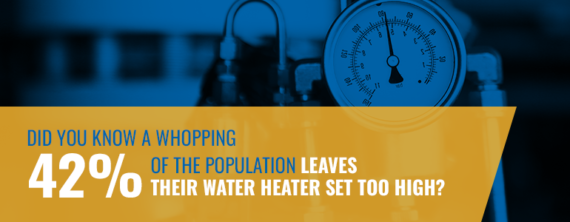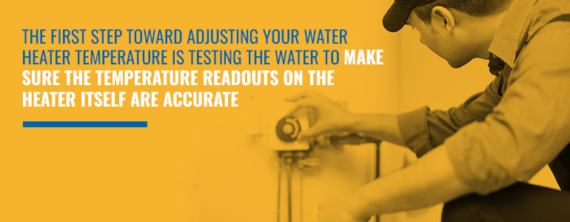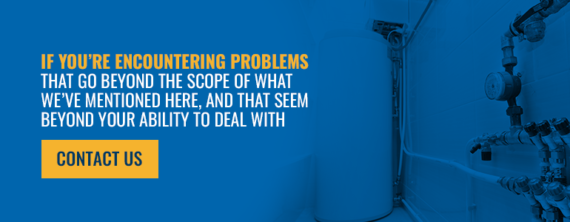How to Adjust the Temperature on Your Water Heater
August 20, 2019Summers in Pennsylvania can be scorching, with temperatures rising into the triple digits.
As the temperatures rise, so too do our electric bills as our air-conditioning units and fans do their best to keep our homes comfortable. For many of us, this makes summer a stressful time as we worry about everything from high electric bills to excessive energy consumption.
One of the easiest things you can do to help your wallet and the planet out this summer is to try adjusting the temperature on your water heater. Your water heater might seem unrelated to keeping you cool, but it’s a big part of your home’s infrastructure and can help you cut down on energy use during this peak energy-consumption season.
Not sure how to do adjust your water heater or how to set the best water heater temperature? This guide shows you how you can complete this small fix yourself.
What Are the Benefits of Adjusting My Water Heater Temperature?
Your water heater controls the temperature of your water, and thus, can deliver water of varying temperatures depending on which knob you turn in the sink or shower. Your water heater works tirelessly to produce hot water. Even at night when you’re in bed sleeping, it’s still plugging away keeping your water hot for your morning shower. But during the summer, much of this work is unnecessary. Because your water heater is working so hard to give you water at the temperature you want, it’s using up tremendous amounts of energy. Often, this translates into sky-high energy bills for you. You’re spending money on energy your appliance doesn’t need to expend in the first place.
The best way to control this type of energy usage in the summer is to adjust the temperature of your water heater by turning it down. By regulating your water heater temp, you better equip it to deal with the strain of higher ambient temperatures. Adjusting your hot water heater in the summer can save you money by making this simple, small tweak. Once you do, there are a few benefits you’ll experience.

1. Save More Money
Your HVAC system is the biggest energy consumer in your home, but your water heater is a close second. Just as your heating and cooling need to work their hardest during the height of winter and summer, your water heater is under the same strain. And while the idea of a mechanical system struggling might sound like an abstract concept, there’s one notable way in which this concept has genuine implications in your day-to-day life — your bills.
Most of us understand more energy usage translates to higher bills. Since we pay for every bit of energy we use, it follows that the more we use, the more we’ll owe to our electric or gas suppliers. Therefore, it also follows that if we want to save money on utilities, the best way of doing so is to cut the amount of energy we’re using. By adjusting the water heater temperature to a lower temperature, cutting our energy usage is exactly what we’re doing.
2. Help the Environment
Each of us can do our part to keep the planet a little bit greener and help the environment. One of the most significant changes you can make as an individual is the decision to consume less energy.
Because your water heater is working so hard to give you water at the temperature you want, it’s using up tremendous amounts of energy. Instead of a hot shower, a warm or cooler shower might feel even more refreshing.
To generate the electricity we use in our homes, power plants must generate that power — fossil fuels, wind, solar and maybe even hydroelectric. You’re spending energy your appliance doesn’t need to expend in the first place, and this too translates into sky-high energy bills for you.
By turning your water heater temperature down, you allow your water heater a little bit of a break. This, in turn, translates to less energy spent, which translates to your home consuming less electricity overall. And just like that, you’ve done your part to keep our planet green and beautiful.
3. Avoid Burns
With the combined forces of a water heater working at full blast and water that already is resting at above-average temperatures, you have a recipe for extremely hot water. In many cases, this water might even cause burns.
One of the best ways to avoid burns is to turn down the water heater. That way, you can feel sure the water will not reach these unprecedentedly high temperatures.
What Is the Recommended Water Heater Temperature?

Did you know a whopping 42% of the population leaves their water heater set too high? Most water heaters will come pre-programmed to rest at 120 degrees Fahrenheit, and many homeowners will not give this temperature a second thought. They leave this temperature set as they install the heater and carry on using it to heat water for their showers, dishwashers and washing machines. The problem is that while this is a decent catch-all temperature setting, it’s also more heat than you need during the summer. As a result, this temperature leads to wasted energy.
To achieve the best temperature, you’ll need to vary the water heater temperature dial to reflect the changing seasons. Going too low creates the risk of bacteria growing in your pipes or water heater, but going too high leads to the danger of burning. To avoid either extreme, you’ll want to find a happy medium. We recommend always keeping the heater set between 110 and 120 degrees.
In the summer, try setting your water heater temperature at the low end of this scale, placing it close to or at 110 degrees. In the winter, lean toward the high end of the range. During this season, 120 is a much more acceptable temperature.
This difference of only 10 degrees or less may not seem like much of a difference, but it can be all you need to save up to 5% in energy spending. You’ll notice the difference in the shower, too, with the water temperature feeling far more comfortable and natural.
How to Adjust Water Heater Temperature
Now that it’s clear why adjusting your water heater temperature is helpful, it’s time to talk practically. How do you change these temperature settings? Is it something you can do yourself, or do you need to call in the professionals?
The process will be slightly different in every case, as each heater and system has a set of varying control mechanisms. Nevertheless, we think the process is simple enough that anyone can complete it on their own. Let’s break things down to demonstrate how you can easily adjust the water heater temperature in your home.
1. Test the Water

The first step toward adjusting your water heater temperature is testing the water to make sure the temperature readouts on the heater itself are accurate. You can complete this test easily by turning on the tap in your sink and letting it run until it reaches maximum heat. Once it’s fully heated, hold a thermometer under the stream and check the temperature. Ideally, it’ll match the setting on the heater.
2. For Tankless Water Heaters
If you have a tankless water heater in your home, you’re in luck. Adjusting the temperature settings couldn’t be easier. The process is very similar to changing your home’s thermostat and requires about as much effort. Use the digital control panel to dial the hot water temperature up or down as desired, and you should be all set.
3. For Gas or Electric Water Heaters
Some gas water heaters may have a straightforward dial located near the bottom of the tank that you can turn to adjust the temperature. In the case of many newer models, however, the process is a little more complicated. Follow these instructions to adjust your electric or gas hot water heater temperature.
- Locate your circuit breaker and turn off power to the water heater.
- Search for the water heater access panel that leads to the thermostat. Once you find it, use a screwdriver to remove the panel and reveal the thermostat underneath.
- If there’s any insulation covering the thermostat, peel this out of the way.
- Using a flat-head screwdriver, adjust the thermostat to your desired position. In some models, you may find your heater has two thermostats. If this is the case, change them both an equal amount. It’s usually best for the top thermostat to rest a few degrees higher than the bottom, so if this is what you encounter, maintain this balance.
- Replace the insulation and screw the panel back into place over the thermostat.
- Head back to the circuit breaker and flick the power to the heater back on.
- If you’re working with a gas water heater, you may also need to relight a pilot light. Check to see whether this may be the case before walking away from the job.
How Do I Know When to Adjust My Water Heater Temperature?
One of the most fundamental ways you can tell that it’s time to adjust your water heater for the season is by running the water in your sink. If it’s winter, turn the tap to hot, and if it’s summer, try running cold water. See how long it takes for the water to come out at your desired temperature. If it does so right away, your water heater is probably fine. If it seems to be taking a while, it might be time to give that water heater thermostat a little fine-tuning.
Another way to decide when to reset your water heater is to mark the dates when you plan to raise or lower the temperature. Perhaps every year, you might set calendar reminders for May 15 and Oct. 1, or whichever dates are appropriate for your climate and location. On these days, you’ll adjust the temperature. This way, you don’t have to worry about running any tests, and can just rest easy knowing you don’t have to do anything until these dates.
Contact a Water Heater Service Professional Today
Can’t seem to locate your water heater thermostat? Or, perhaps you have found it and made the suggested adjustments, but nothing seems to have changed. If you’re encountering problems like a broken water heater, a leaking water heater, or you need water heater installation, it may be time to call in the pros.
Here at Summers & Zim’s, we want to be your water heater service professionals. We serve Lancaster, Delaware and Chester counties, and we make it our business to get the job done right the first time around. With our service-first attitude, friendly approach to helping our customers and extensive knowledge of how water heaters and other home appliances work, we have everything you might be looking for in a team of home service providers.
Are you ready to start getting to the bottom of your question? Contact us today. We’re looking forward to hearing from you!
